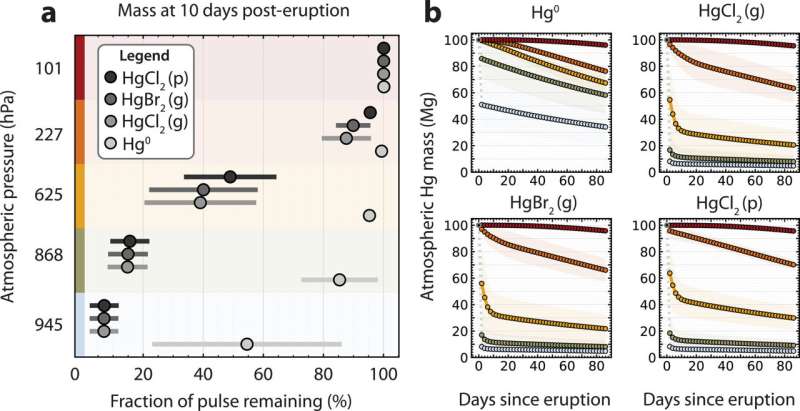This article has been reviewed according to Science X's editorial process and policies. Editors have highlighted the following attributes while ensuring the content's credibility:
fact-checked
peer-reviewed publication
trusted source
proofread
Human emissions have increased mercury in the atmosphere sevenfold: Study

Humans have increased the concentration of potentially toxic mercury in the atmosphere sevenfold since the beginning of the modern era around 1500 C.E., according to new research from the Harvard John A. Paulson School of Engineering and Applied Sciences (SEAS).
The research team, led by Elsie M. Sunderland, the Fred Kavli Professor of Environmental Chemistry and Professor of Earth and Planetary Sciences, developed a new method to accurately estimate how much mercury is emitted annually from volcanos, the largest single natural emitter of mercury. The team used that estimate—along with a computer model—to reconstruct pre-anthropogenic atmospheric mercury levels.
The researchers estimated that before humans started pumping mercury into the atmosphere, it contained on average about 580 megagrams of mercury. However, in 2015, independent research that looked at all available atmospheric measurements estimated the atmospheric mercury reservoir was about 4,000 Mg—nearly 7 times larger than the natural condition estimated in this study.
Human emissions of mercury from coal-fired power plants, waste-incineration, industry and mining make up the difference.
"Methylmercury is a potent neurotoxicant that bioaccumulates in fish and other organisms—including us," said Sunderland, senior author of the paper. "Understanding the natural mercury cycle driven by volcanic emissions sets a baseline goal for policies aimed at reducing mercury emissions and allows us to understand the full impact of human activities on the environment."
The research is published in Geophysical Research Letters.
The challenge with measuring mercury in the atmosphere is that there's not very much of it, despite its outsized impact on human health. In a cubic meter of air, there may be only a nanogram of mercury, making it virtually impossible to detect via satellite. Instead, the researchers needed to use another chemical emitted in tandem with mercury as a proxy. In this case, the team used sulfur dioxide, a major component of volcanic emissions.
"The nice thing about sulfur dioxide is that it's really easy to see using satellites," said Benjamin Geyman, a Ph.D. student in Environmental Science & Engineering at SEAS and first author of the paper. "Using sulfur dioxide as a proxy for mercury allows us to understand where and when volcanic mercury emissions are occurring."
Using a compilation of mercury to sulfur dioxide ratios measured in volcanic gas plumes, the researchers reverse engineered how much mercury could be attributed to volcanic eruptions. Then, using the GEOS-Chem atmospheric model, they modeled how mercury from volcanic eruptions moved across the globe.
The team found that while mercury mixes into the atmosphere and can travel long distances from its injection site, volcanic emissions are directly responsible for only a few percent of ground level concentrations in most areas on the planet. However, there are areas— such as in South America, the Mediterranean and the Ring of Fire in the Pacific—where levels of volcanic emissions of mercury make it harder to track human emissions.
"In Boston, we can do our local monitoring and we don't have to think about whether it was a big volcano year or a small volcano year," said Geyman.
"But in a place like Hawaii, you've got a big source of natural mercury that is highly variable over time. This map helps us understand where volcanos are important and where they aren't, which is really useful for understanding the impact of humans on long-term mercury trends in fish, in the air and in the ocean. It's important to be able to correct for natural variability in the volcanic influence in places where we think that influence may not be negligible."
More information: Benjamin M. Geyman et al, Impacts of Volcanic Emissions on the Global Biogeochemical Mercury Cycle: Insights From Satellite Observations and Chemical Transport Modeling, Geophysical Research Letters (2023). DOI: 10.1029/2023GL104667
Journal information: Geophysical Research Letters




















